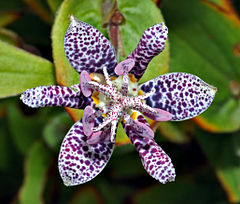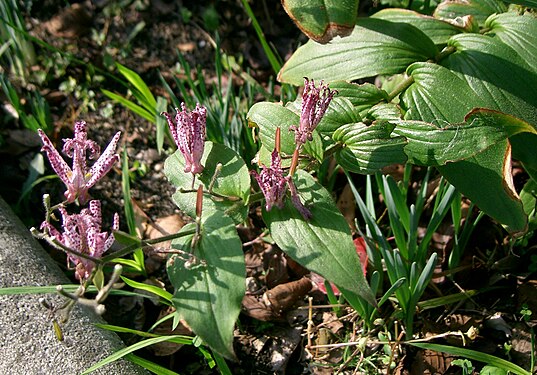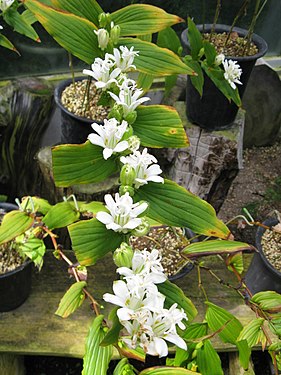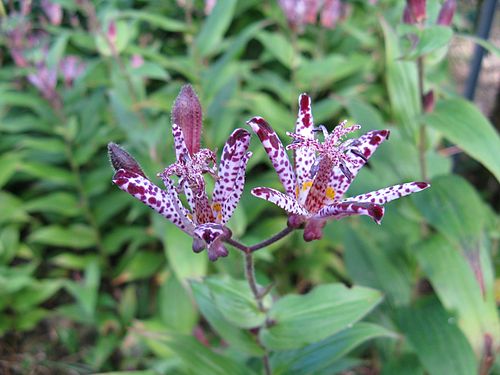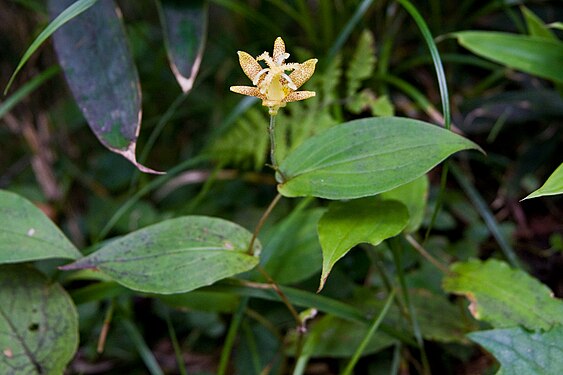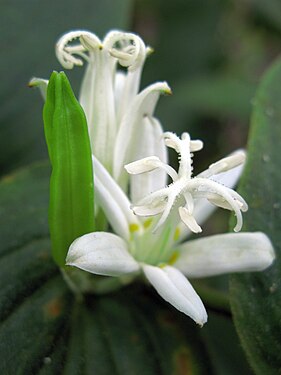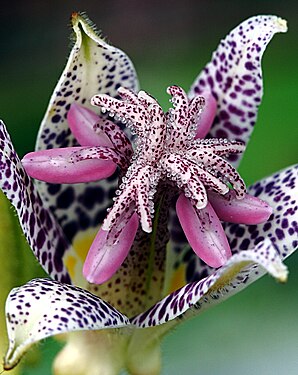Difference between revisions of "Tricyrtis"
| (One intermediate revision by the same user not shown) | |||
| Line 4: | Line 4: | ||
|common_name=Toad lily | |common_name=Toad lily | ||
|name_ref=Flora - A Gardener's Encyclopedia | |name_ref=Flora - A Gardener's Encyclopedia | ||
| + | |habit=herbaceous | ||
| + | |lifespan=perennial | ||
|Temp Metric=°F | |Temp Metric=°F | ||
|jumpin=If this plant info box on watering; zones; height; etc. is mostly empty you can click on the edit tab and fill in the blanks! | |jumpin=If this plant info box on watering; zones; height; etc. is mostly empty you can click on the edit tab and fill in the blanks! | ||
| − | |image= | + | |image=Tricyrtis hirta - blossom top (aka).jpg |
|image_width=240 | |image_width=240 | ||
| + | |image_caption=Tricyrtis hirta | ||
}} | }} | ||
| − | + | '''''Tricyrtis''''' is a [[genus (biology)|genus]] of the [[botany|botanical]] [[family (biology)|family]] [[Liliaceae]], known in English as Toad lilies. Its native range is from the Himalayas to eastern Asia, including China,<ref name="china">{{cite web | work = Flora of China | url = http://efloras.org/florataxon.aspx?flora_id=2&taxon_id=133597 | title = Tricyrtis Wallich }}</ref> Japan,<ref>{{citation | url = http://www.amjbot.org/cgi/content/full/86/2/287 | doi = 10.2307/2656945 | title = The Effect of Geographic Range and Dichogamy on Genetic Variability and Population Genetic Structure in Tricyrtis Section Flavae (Liliaceae) | year = 1999 | author = Maki, Masayuki | journal = American Journal of Botany | volume = 86 | pages = 287 }}</ref> [[Philippines]] and [[Formosa]].<ref name=George2002>{{Citation| last = George Schmid | first = W.| year = 2002| title = An encyclopedia of shade perennials| pages = 312| url = http://books.google.com/books?id=oKVsZdgB-QEC&pg=RA1-PA312&dq=Tricyrtis+are+native+from&ei=5OB9SdeFLYnIMuia6bIE&client=firefox-a#PRA1-PA312,M1| isbn = 0881925497| publisher = Timber Press| location = Portland, Or.}}</ref> | |
| − | + | ||
| − | | | + | They are perennial [[herbaceous plant]]s that grow naturally at the edge of forests. They prefer shade or part shade and rich, moist soil. Toad Lilies bloom in the fall. They are hardy enough to handle the sudden changes of Midwest(US) winters from mild to blustery cold.<ref>Cox, Jeff (1998 by Rodale Press) Perennial All-Stars: The 150 Best Perennials for Great-Looking, Trouble-Free Gardens, pg. 305 </ref> |
| − | | | + | |
| − | | | ||
| − | | | ||
| − | |||
| − | | | ||
| − | | | ||
| − | | | ||
| − | | | ||
| − | | | ||
| − | | | ||
| − | | | ||
| − | | | ||
| − | | | ||
| − | | | ||
| − | | | ||
| − | |||
| − | | | ||
| − | | | ||
| − | | | ||
| − | |||
| − | |||
| − | |||
| − | |||
| − | |||
| − | |||
| − | |||
| − | |||
{{Inc| | {{Inc| | ||
| − | |||
Tricyrtis (Greek, three convexities, referring to the nectar-bearing sacs at the base of the three outer perianth-segments). Liliaceae. Toad-Lilies. Half-hardy perennials, pretty garden plants; also used for pot culture. | Tricyrtis (Greek, three convexities, referring to the nectar-bearing sacs at the base of the three outer perianth-segments). Liliaceae. Toad-Lilies. Half-hardy perennials, pretty garden plants; also used for pot culture. | ||
| Line 59: | Line 35: | ||
==Species== | ==Species== | ||
| − | < | + | Species include: |
| + | |||
| + | * ''[[Tricyrtis affinis]]'' <small>[[Tomitaro Makino|Makino]]</small> | ||
| + | * ''[[Tricyrtis amethystina]]'' <small>[[Genkei Masamune|Masam.]]</small> | ||
| + | * ''[[Tricyrtis chinensis]]'' <small>[[Hiroshi Takahashi (botanist)|Hiroshi Takahashi]] </small> | ||
| + | * ''[[Tricyrtis formosana]]'' | ||
| + | * ''[[Tricyrtis hirta]]'' <small>([[Carl Peter Thunberg|Thunb.]]) [[William Jackson Hooker|Hook.]]</small> | ||
| + | * ''[[Tricyrtis latifolia]]'' <small>[[Carl Maximowicz|Maxim.]]</small> | ||
| + | * ''[[Tricyrtis macrantha]]'' | ||
| + | * ''[[Tricyrtis macropoda]]'' <small>[[Friedrich Anton Wilhelm Miquel|Miq.]]</small> | ||
| + | * ''[[Tricyrtis stolonifera]] | ||
| + | * ''[[Tricyrtis viridula]]'' <small>[[Hiroshi Takahashi (botanist)|Hiroshi Takahashi]]</small> | ||
| + | * ''[[Tricyrtis yatabeana]]'' <small>[[Genkei Masamune|Masam.]]</small> | ||
==Gallery== | ==Gallery== | ||
| − | + | <gallery perrow=5> | |
| − | + | File:Tricyrtis cv2.jpg | |
| − | + | File:Tricyrtis affinis2.jpg | |
| − | + | File:Tricyrtis cv1.jpg | |
| − | + | File:Tricyrtis formosana.jpg | |
| − | + | File:Tricyrtis macranthopsis2.jpg | |
| + | File:Tricyrtis macranthopsis1.jpg | ||
| + | File:Tricyrtis hirta1.jpg | ||
| + | File:Tricyrtis macrantha2.jpg | ||
| + | File:Tricyrtis 'Sinonome'2.jpg | ||
| + | File:Tricyrtis latifolia 01.jpg | ||
| + | File:Tricyrtis latifolia.jpg | ||
| + | File:Tricyrtis formosana 1.jpg | ||
| + | File:Tricyrtis hirta.jpg | ||
| + | File:Tricyrtis hirta f. albescens1613791163.jpg | ||
| + | File:Japanische Krötenlilie (Tricyrtis hirta) 7283.JPG | ||
</gallery> | </gallery> | ||
| Line 80: | Line 78: | ||
{{stub}} | {{stub}} | ||
| − | + | __NOTOC__ | |
| − | |||
| − | |||
Latest revision as of 05:16, 30 April 2010
| Habit | herbaceous
| |
|---|---|---|
| Lifespan: | ⌛ | perennial |
If this plant info box on watering; zones; height; etc. is mostly empty you can click on the edit tab and fill in the blanks!
Tricyrtis is a genus of the botanical family Liliaceae, known in English as Toad lilies. Its native range is from the Himalayas to eastern Asia, including China,[1] Japan,[2] Philippines and Formosa.[3]
They are perennial herbaceous plants that grow naturally at the edge of forests. They prefer shade or part shade and rich, moist soil. Toad Lilies bloom in the fall. They are hardy enough to handle the sudden changes of Midwest(US) winters from mild to blustery cold.[4]
Read about Tricyrtis in the Standard Cyclopedia of Horticulture
|
|---|
|
Tricyrtis (Greek, three convexities, referring to the nectar-bearing sacs at the base of the three outer perianth-segments). Liliaceae. Toad-Lilies. Half-hardy perennials, pretty garden plants; also used for pot culture. Rhizome short-creeping: sts. erect; simple below the infl., leafy: infl. terminal, or laxly dichotomous in the upper axils: fls. few, rather large, somewhat long-pedicelled; perianth usually beautifully spotted inside, campanulate, segms. distinct from the base, lanceolate, acute; stamens 6; ovary oblong, 3-cornered, 3-celled: caps. narrowly oblong, prominently 3-cornered, septicidally dehiscent, erect, usually more than 1 in. long.— About 9 species, native to Japan and Formosa. Monographed by J. G. Baker in Journal Linnaean Society, vol. 17, p. 463 (1879). T. grandiflora, Hort., should be compared with T. hirta var. nigra. It is a name scarcely known to botany. It is said to have orchid-like fragrant fls. in Oct. and Nov. (Baker says the genus has no fragrant fls.). Dutch growers say that T. grandiflora, has white fls. mottled with black. CH
|
Cultivation
- Do you have cultivation info on this plant? Edit this section!
Propagation
- Do you have propagation info on this plant? Edit this section!
Pests and diseases
- Do you have pest and disease info on this plant? Edit this section!
Species
Species include:
- Tricyrtis affinis Makino
- Tricyrtis amethystina Masam.
- Tricyrtis chinensis Hiroshi Takahashi
- Tricyrtis formosana
- Tricyrtis hirta (Thunb.) Hook.
- Tricyrtis latifolia Maxim.
- Tricyrtis macrantha
- Tricyrtis macropoda Miq.
- Tricyrtis stolonifera
- Tricyrtis viridula Hiroshi Takahashi
- Tricyrtis yatabeana Masam.
Gallery
References
- Standard Cyclopedia of Horticulture, by L. H. Bailey, MacMillan Co., 1963
External links
- w:Tricyrtis. Some of the material on this page may be from Wikipedia, under the Creative Commons license.
- Tricyrtis QR Code (Size 50, 100, 200, 500)
- ↑ "Tricyrtis Wallich". Flora of China.
- ↑ Template:Citation
- ↑ Template:Citation
- ↑ Cox, Jeff (1998 by Rodale Press) Perennial All-Stars: The 150 Best Perennials for Great-Looking, Trouble-Free Gardens, pg. 305
